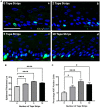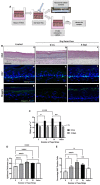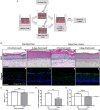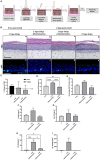Development of a novel in vitro strategy to understand the impact of shaving on skin health: combining tape strip exfoliation and human skin equivalent technology
- PMID: 38020123
- PMCID: PMC10652890
- DOI: 10.3389/fmed.2023.1236790
Development of a novel in vitro strategy to understand the impact of shaving on skin health: combining tape strip exfoliation and human skin equivalent technology
Abstract
Introduction: The removal of unwanted hair is a widespread grooming practice adopted by both males and females. Although many depilatory techniques are now available, shaving remains the most common, despite its propensity to irritate skin. Current techniques to investigate the impact of shaving regimes on skin health rely on costly and lengthy clinical trials, which hinge on recruitment of human volunteers and can require invasive biopsies to elucidate cellular and molecular-level changes.
Methods: Well-characterised human skin equivalent technology was combined with a commonplace dermatological technique of tape stripping, to remove cellular material from the uppermost layer of the skin (stratum corneum). This method of exfoliation recapitulated aspects of razor-based shaving in vitro, offering a robust and standardised in vitro method to study inflammatory processes such as those invoked by grooming practices.
Results: Tape strip insult induced inflammatory changes in the skin equivalent such as: increased epidermal proliferation, epidermal thickening, increased cytokine production and impaired barrier function. These changes paralleled effects seen with a single dry razor pass, correlated with the number of tape strips removed, and were attenuated by pre-application of shaving foam, or post-application of moisturisation.
Discussion: Tape strip removal is a common dermatological technique, in this study we demonstrate a novel application of tape stripping, to mimic barrier damage and inflammation associated with a dry shave. We validate this method, comparing it to razor-based shaving in vitro and demonstrate the propensity of suitable shave- and skin-care formulations to mitigate damage. This provides a novel methodology to examine grooming associated damage and a platform for screening potential skin care formulations.
Keywords: exfoliation; inflammation; shaving; skin equivalent; stratum corneum; tape strip.
Copyright © 2023 Costello, Goncalves, Maltman, Barrett, Shah, Stephens, Dicolandrea, Ambrogio, Hodgson and Przyborski.
Conflict of interest statement
Author SP collaborates and acts as a technical consultant for company Reprocell Europe Ltd. KS, AS, IA, and EH are full-time employees of Procter & Gamble (Reading, Berkshire, United Kingdom). TD is a full-time employee of Proctor & Gamble (Cincinnati, OH, United States). The remaining authors declare that the research was conducted in the absence of any commercial or financial relationships that could be construed as a potential conflict of interest.
Figures






Similar articles
-
Effect of shaving on axillary stratum corneum.Int J Cosmet Sci. 2003 Aug;25(4):193-8. doi: 10.1046/j.1467-2494.2003.00186.x. Int J Cosmet Sci. 2003. PMID: 18494901
-
The tape stripping procedure--evaluation of some critical parameters.Eur J Pharm Biopharm. 2009 Jun;72(2):317-23. doi: 10.1016/j.ejpb.2008.08.008. Epub 2008 Aug 19. Eur J Pharm Biopharm. 2009. PMID: 18775778
-
Characteristic differences in barrier and hygroscopic properties between normal and cosmetic dry skin. I. Enhanced barrier analysis with sequential tape-stripping.Int J Cosmet Sci. 2014 Apr;36(2):167-74. doi: 10.1111/ics.12112. Epub 2014 Jan 31. Int J Cosmet Sci. 2014. PMID: 24397786 Clinical Trial.
-
Shaving effects on percutaneous penetration: clinical implications.Cutan Ocul Toxicol. 2015;34(4):335-43. doi: 10.3109/15569527.2014.966109. Epub 2014 Nov 3. Cutan Ocul Toxicol. 2015. PMID: 25363065 Review.
-
The biomechanics of blade shaving.Int J Cosmet Sci. 2016 Jun;38 Suppl 1:17-23. doi: 10.1111/ics.12330. Int J Cosmet Sci. 2016. PMID: 27212467 Review.
Cited by
-
Implications of Long-Term Double Eyelid Tape Use.Aesthetic Plast Surg. 2025 Jan;49(1):75-86. doi: 10.1007/s00266-024-04453-9. Epub 2024 Oct 21. Aesthetic Plast Surg. 2025. PMID: 39433617
-
Investigation into the significant role of dermal-epidermal interactions in skin ageing utilising a bioengineered skin construct.J Cell Physiol. 2025 Jan;240(1):e31463. doi: 10.1002/jcp.31463. Epub 2024 Oct 8. J Cell Physiol. 2025. PMID: 39377615 Free PMC article.
-
Bioengineering the Human Intestinal Mucosa and the Importance of Stromal Support for Pharmacological Evaluation In Vitro.Cells. 2024 Nov 8;13(22):1859. doi: 10.3390/cells13221859. Cells. 2024. PMID: 39594608 Free PMC article.
-
Engineering a Multilayered Skin Equivalent: The Importance of Endogenous Extracellular Matrix and Model Flexibility for Nuanced and Accurate Skin Studies.Methods Mol Biol. 2025;2922:153-172. doi: 10.1007/978-1-0716-4510-9_12. Methods Mol Biol. 2025. PMID: 40208534
References
-
- Tiggemann M, Kenyon SJ. The hairlessness norm: the removal of body hair in women. Sex Roles. (1998) 39:873–85. doi: 10.1023/A:1018828722102 - DOI
-
- Tiggemann M, Hodgson S. The hairlessness norm extended: reasons for and predictors of women’s body hair removal at different body sites. Sex Roles. (2008) 59:889–97. doi: 10.1007/s11199-008-9494-3 - DOI
-
- Rodan K, Fields K, Falla TJ. Efficacy and tolerability of a twice-daily, three-step men’s skincare regimen in improving overall skin quality and reducing shave-related irritation. Skinmed. (2017) 15:349–55. - PubMed
LinkOut - more resources
Full Text Sources

